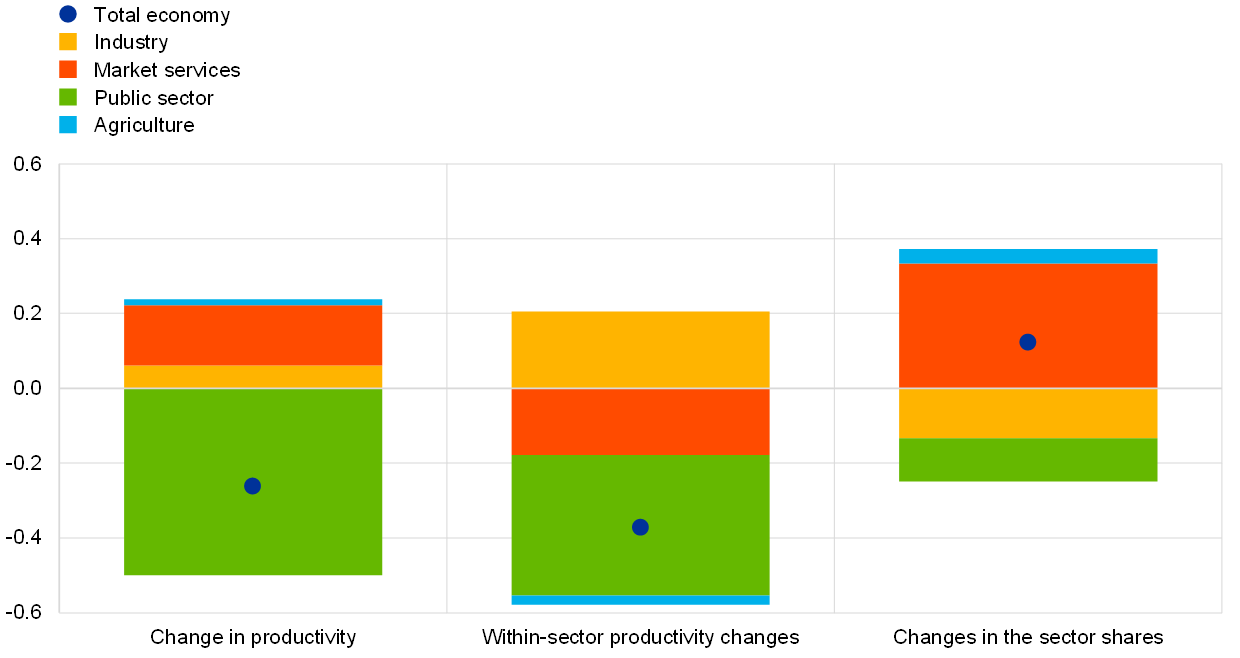Published as part of the ECB Economic Bulletin, Issue 6/2022.
Employment growth in the public sector has played an important role in supporting total employment during the coronavirus (COVID-19) pandemic.[1] In the first quarter of 2022, public employment was about 3.5% above pre-pandemic levels, compared with 0.6% in industry and 0.2% in market services (Chart A, panel a). Similarly, total hours worked in the public sector reached pre-pandemic levels in the first quarter of 2021 and were 1.7% above pre-pandemic levels in the first quarter of 2022. By contrast, total hours worked in the private sector remained 1.1% below pre-pandemic levels in the first quarter of 2022 (Chart A, panel b).[2] Looking at the largest countries, Germany, Spain and France have experienced a strong positive contribution from public employment, while the contribution in Italy has been more modest.
Chart A
Euro area employment and total hours across sectors
(index: Q4 2019 = 100)
Source: Authors’ calculations based on Eurostat data.
Note: The latest observations are for the first quarter of 2022.
While during past recessions in the euro area, employment in the public sector also increased more than in other sectors, the increase this time has been stronger than in past recessions. Chart B shows the different percentage point contributions to cumulative employment growth following the 2008 financial crisis and the euro area sovereign debt crisis. In both cases, public employment displayed a similar pattern to that observed in the COVID-19 pandemic recovery, contributing positively to total employment growth. However, the increase in public employment during the pandemic has been stronger than in past recessions. The positive contribution of public employment is mostly determined by the positive long-term trends in the health and education sectors (Chart C). These positive trends may be related to population ageing, calling for higher expenditure in health-related services, and to the increasing share of tertiary education over time. Health expenditure is higher across older cohorts, and an ageing society will call for greater expenditure on health services.[3] In addition, across OECD countries, expenditure per student on primary to tertiary educational institutions grew at an average rate of 1.6% per year between 2012 and 2018, while the number of students remained stable.[4]
Chart B
Euro area employment in past recessions
a) 2008 financial crisis
(index: Q2 2008 = 100)

b) Euro area sovereign debt crisis
(index: Q4 2011 = 100)
Source: Authors’ calculations based on Eurostat data.
In contrast to past episodes, the increase in public employment during the pandemic is associated with a rise in the share of temporary workers. About two-thirds of the 3.1% contraction in total employment at the beginning of the pandemic was due to a 15% fall in temporary employment, driven by the decline in employment in the private sector. This is a normal feature of recessions, when employees with temporary contracts tend to be dismissed first or do not have their contracts renewed. However, temporary employment in the public sector during the COVID-19 crisis has behaved differently from that in the private sector and compared with previous crises. In the first quarter of 2022, it was 11.5% above the pre-pandemic level, and its share in total public sector employment had increased by 2 percentage points. This increase has been mostly concentrated in health and education (Chart C). The health and education sectors have added 1.4 million jobs (almost 1 million on temporary contracts), which is about 22% of the total employment creation since the second quarter of 2020. During the COVID-19 crisis the increase in hospitalisation, testing and vaccination rates, as well as the social distancing measures, may have led to higher temporary hiring rates in the health and education sectors to accommodate the temporary pandemic-related restrictions.
Chart C
Employment in public administration, education and health
(millions of persons)
Source: Authors’ calculations based on Eurostat data.
Note: The latest observations are for the first quarter of 2022.
The increase in temporary workers in the public sector is likely to have contributed negatively to aggregate labour productivity. Over the COVID-19 pandemic period the contribution of the public sector to the change in overall labour productivity has been -0.5 percentage points (Chart D). Based on a shift-share analysis, most of the changes during the period from the fourth quarter of 2019 to the first quarter of 2022 were driven by changes within the public sector (-0.4 percentage points) and, to a lesser extent, by the increase in the share of public employment in the total economy. As a large part of employment growth within the public sector has been driven by the growth in temporary jobs, the productivity trend can be attributed to the strong rise in temporary employment in education and health. Employees on temporary contracts are typically paid less than permanent employees. Productivity figures for non-market activities are mainly affected by labour costs. An increase in temporary contracts – which are characteristic of jobs with lower skill content or lower seniority – could partly explain the decline in productivity growth in the public sector.[5] Another contributing element is the decline in average hours worked.
Chart D
Change in productivity
(percentage changes during the period from Q4 2019 to Q1 2022)
Source: Authors’ calculations based on Eurostat data.
Note: The chart shows a shift-share analysis of the cumulative growth rate of labour productivity per employee between changes within each sector and changes in the shares across sectors (change in the weight).
The increase in temporary employment in the public sector could be partly reversed once COVID-19-related health measures are phased out, but the effects of such a reversal would probably be limited to 0.2% of the euro area labour force. Temporary employment in the education and health sectors remains above the respective long-term trends.[6] A reversal back to trend growth would imply a reduction in temporary jobs in the public sector of about 300,000 persons, potentially adding 0.2 percentage points to the euro area unemployment rate if these jobs are not reallocated to other sectors.

